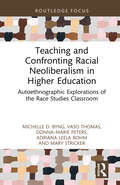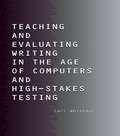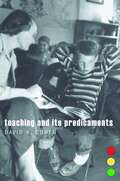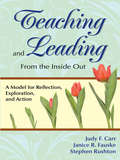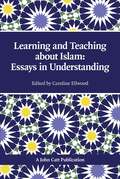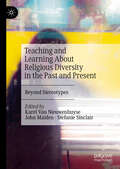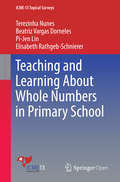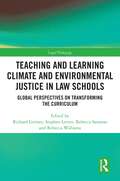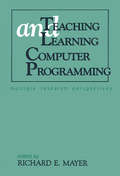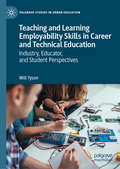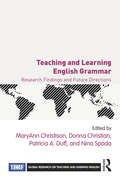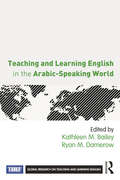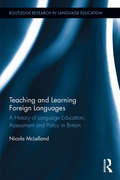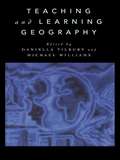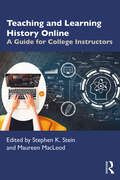- Table View
- List View
Teaching and Coaching Lifestyle Sports: Research and Practice
by Thomas M. Leeder Lee C. BeaumontLifestyle sports have witnessed unprecedented growth in recent years, with it being accepted that these activities can contribute significantly to national sport and physical activity agendas, appeal to contemporary youth culture, and provide an alternative to mainstream achievement sports within school physical education. However, this popularity has led to increased professionalisation and institutionalisation, meaning there is now a demand for educated teachers and coaches to facilitate learning through effective pedagogical approaches. Consequently, Teaching and Coaching Lifestyle Sports: Research and Practice is the first book of its kind to provide both theoretical and empirical insights into the process and practice of teaching and coaching lifestyle sports across school, community, and high-performance sport contexts.Drawing upon a variety of lifestyle sports including skateboarding, freestyle BMX, parkour, and freeskiing, this book develops readers’ understanding and conceptualisation of the issues, challenges, and opportunities associated with teaching and coaching lifestyle sports. Each chapter, grouped via a broad focus on either teaching or coaching, offers novel perspectives towards current trends, pedagogical approaches, and ‘steps forward’ in relation to lifestyle sports within physical education and sport coaching. This book covers contemporary and important topics within lifestyle sports, such as coach development, enhancing youth sport participation, facilitating athlete learning, and creating a ‘meaningful’ physical education experience. Drawing upon global examples, each chapter generates new knowledge associated with the teaching and coaching of lifestyle sports, while critically discussing areas for future research alongside practical implications for teachers, coaches, and sports organisations. Teaching and Coaching Lifestyle Sports: Research and Practice is a valuable resource for researchers and academics, in addition to students and practitioners, who are currently working across the overlapping fields of physical education, sport coaching, sport development, and leisure studies, or have an interest in lifestyle sports.
Teaching and Confronting Racial Neoliberalism in Higher Education: Autoethnographic Explorations of the Race Studies Classroom (Routledge Research in Race and Ethnicity in Education)
by Michelle D. Byng Vaso Thomas Donna-Marie Peters Adriana Leela Bohm Mary StrickerThis book examines the way in which professors must confront the social implications of racial neoliberalism. Drawing on autoethnographic research from the authors’ combined 100 years of teaching experience, it recognizes the need for faculty to negotiate their own experiences with race, as well as those of their students. It focuses on the experiential nature of teaching, supplementing the fields’ focus on pedagogy, and recognizes that professors must, in fact, highlight, rather than downplay, the realities of racial inequalities of the past and present. It explores the ability of instructors to make students who are not of color feel that they are not racists, as well as their ability to make students of color feel that they can present their experiences of racism as legitimate. A unique sociological analysis of the racial studies classroom, this book will be of value to researchers, scholars and faculty with interests in race and ethnicity in education; diversity studies; equity; pedagogy; and the sociology of education, teaching, and learning.
Teaching and Digital Technologies
by Michael Henderson Geoff RomeoTeaching and Digital Technologies: Big Issues and Critical Questions helps both pre-service and in-service teachers to critically question and evaluate the reasons for using digital technology in the classroom. Unlike other resources that show how to use specific technologies – and quickly become outdated, this text empowers the reader to understand why they should (or should not) use digital technologies, when it is appropriate (or not), and the implications arising from these decisions. The text directly engages with policy, the Australian Curriculum, pedagogy, learning and wider issues of equity, access, generational stereotypes and professional learning. The contributors to the book are notable figures from across a broad range of Australian universities, giving the text a unique relevance to Australian education while retaining its universal appeal. Teaching and Digital Technologies is an essential contemporary resource for early childhood, primary and secondary pre-service and in-service teachers in both local and international education environments.
Teaching and Evaluating Writing in the Age of Computers and High-Stakes Testing
by Carl WhithausThis book takes on a daunting task: How do writing teachers continue to work toward preparing students for academic and real-world communication situations, while faced with the increasing use of standardized high-stakes testing? Teachers need both the technical ability to deal with this reality and the ideological means to critique the information technologies and assessment methods that are transforming the writing classroom.Teaching and Evaluating Writing in the Age of Computers and High-Stakes Testing serves this dual need by offering a theoretical framework, actual case studies, and practical methods for evaluating student writing. By examining issues in writing assessment--ranging from the development of electronic portfolios to the impact of state-wide, standards-based assessment methods on secondary and post-secondary courses--this book discovers four situated techniques of authentic assessment that are already in use at a number of locales throughout the United States. These techniques stress:*interacting with students as communicators using synchronous and asynchronous environments;*describing the processes and products of student learning rather than enumerating deficits;*situating pedagogy and evaluation within systems that incorporate rather than exclude local variables; and*distributing assessment among diverse audiences.By advocating for a flexible system of communication-based assessment in computer-mediated writing instruction, this book validates teachers' and students' experiences with writing and also acknowledges the real-world weight of the new writing components on the SAT and ACT, as well as on state-mandated standardized writing and proficiency exams.
Teaching and Its Predicaments
by David K. CohenEver since Socrates, teaching has been a difficult and even dangerous profession. Why is good teaching such hard work? In this provocative, witty, and sometimes rueful book, David K. Cohen writes about the predicaments that teachers face. Like therapists, social workers, and pastors, teachers embark on a mission of human improvement. They aim to deepen knowledge, broaden understanding, sharpen skills, and change behavior. One predicament is that no matter how great their expertise, teachers depend on the cooperation and intelligence of their students, yet there is much that students do not know. To teach responsibly, teachers must cultivate a kind of mental double vision: distancing themselves from their own knowledge to understand students’ thinking, yet using their knowledge to guide their teaching. Another predicament is that although attention to students’ thinking improves the chances of learning, it also increases the uncertainty and complexity of the job. The circumstances in which teachers and students work make a difference. Teachers and students are better able to manage these predicaments if they have resources—common curricula, intelligent assessments, and teacher education tied to both—that support responsible teaching. Yet for most of U.S. history those resources have been in short supply, and many current accountability policies are little help. With a keen eye for the moment-to-moment challenges, Cohen explores what “responsible teaching” can be, the kind of mind reading it seems to demand, and the complex social resources it requires.
Teaching and Leading From the Inside Out: A Model for Reflection, Exploration, and Action
by Judy F. Carr Janice R. Fauske Stephen P. RushtonThis insightful resource provides vignettes, questions, and practical strategies for implementing individual and schoolwide practices to connect internal beliefs and aspirations to external action.
Teaching and Learning About Islam: Essays In Understanding
by Adam Boxer Caroline EllwoodWith a foreword by HRH Prince El Hassan bin Talal of Jordan, this collection of contributions from leading contributors on the teaching of Islam in schools is aimed as a step towards improving intercultural understanding.
Teaching and Learning About Islam: Essays In Understanding
by Adam Boxer Caroline EllwoodWith a foreword by HRH Prince El Hassan bin Talal of Jordan, this collection of contributions from leading contributors on the teaching of Islam in schools is aimed as a step towards improving intercultural understanding.
Teaching and Learning About Religious Diversity in the Past and Present: Beyond Stereotypes
by John Maiden Karel Van Nieuwenhuyse Stefanie SinclairThis edited book explores examples of different ways in which societies and individuals have dealt with the concepts of religious diversity, toleration and peace-making in politics and law, and how these examples can inform educators and learners in (in- and non-)formal education today. Chapters introduce and analyse nine key documents: the Capitulations of Granada (1492), the Confederation of Warsaw (1573), the Peace of Westphalia (1648), the Royal Charter of Rhode Island (1663), the Declaration of the Rights of Man and of the Citizen (1789), the European Convention of Human Rights (1950), the Belfast/ Good Friday Agreement (1998), the Ohrid Framework Agreement (2001) and the Mardin Declaration (2010). In addition to explaining how each document manages toleration and peace, the authors also provide ‘clippings’, short visual and textual excerpts relating to the document under discussion. These aim to challenge thinking about the historical document and its potential significance for the present. The book’s contributors consider the past as a source of inspiration for learning in formal and informal educational contexts such as classrooms, museums and youth work. It will be of interest to teachers and scholars in history, citizenship, philosophy, ethics and religious education in schools and beyond.
Teaching and Learning About Whole Numbers in Primary School
by Terezinha Nunes Beatriz Vargas Dorneles Pi-Jen Lin Elisabeth Rathgeb-SchniererThis book offers a theory for the analysis of how children learn and are taught about whole numbers. Two meanings of numbers are distinguished - the analytical meaning, defined by the number system, and the representational meaning, identified by the use of numbers as conventional signs that stand for quantities. This framework makes it possible to compare different approaches to making numbers meaningful in the classroom and contrast the outcomes of these diverse aspects of teaching. The book identifies themes and trends in empirical research on the teaching and learning of whole numbers since the launch of the major journals in mathematics education research in the 1970s. It documents a shift in focus in the teaching of arithmetic from research about teaching written algorithms to teaching arithmetic in ways that result in flexible approaches to calculation. The analysis of studies on quantitative reasoning reveals classifications of problem types that are related to different cognitive demands and rates of success in both additive and multiplicative reasoning. Three different approaches to quantitative reasoning education illustrate current thinking on teaching problem solving: teaching reasoning before arithmetic, schema-based instruction, and the use of pre-designed diagrams. The book also includes a summary of contemporary approaches to the description of the knowledge of numbers and arithmetic that teachers need to be effective teachers of these aspects of mathematics in primary school. The concluding section includes a brief summary of the major themes addressed and the challenges for the future. The new theoretical framework presented offers researchers in mathematics education novel insights into the differences between empirical studies in this domain. At the same time the description of the two meanings of numbers helps teachers distinguish between the different aims of teaching about numbers supported by diverse methods used in primary school. The framework is a valuable tool for comparing the different methods and identifying the various assumptions about teaching and learning.
Teaching and Learning Arabic Grammar: Theory, Practice, and Research
by Kassem M. Wahba Zeinab A. Taha Manuela E. B. GiolfoFoundational and comprehensive, this volume provides a theoretical and practical overview of the current issues that dominate the field of teaching and learning Arabic grammar. Bringing together authorities on Arabic grammar from around the world, the book covers both historical contexts and current practices, and provides principles, strategies, and examples of current Arabic grammar instruction across educational settings. Chapter authors offer a range of perspectives on teaching approaches, implementing research findings in the classroom, and future challenges. A much-needed volume to help students, teachers, and teacher educators develop their knowledge and skills, it addresses the most salient and controversial issues in the field, including: what grammar to teach, how much grammar to teach, how to address grammar in content-based or communication-based classroom, and how to teach variation in grammar. This resource is ideal for preservice Arabic language teachers as well as Arabic language professors and researchers.
Teaching and Learning Argumentative Writing in High School English Language Arts Classrooms
by Alan Hirvela George E. Newell David BloomeFocused on the teaching and learning argumentative writing in grades 9-12, this important contribution to literacy education research and classroom practice offers a new perspective, a set of principled practices, and case studies of excellent teaching. The case studies illustrate teaching and learning argumentative writing as the construction of knowledge and new understandings about experiences, ideas, and texts. Six themes key to teaching argumentative writing as a thoughtful, multi‐leveled practice for deep learning and expression are presented: teaching and learning argumentative writing as social practice, teachers’ epistemological beliefs about argumentative writing, variations in instructional chains, instructional conversations in support of argumentative writing as deep learning and appreciation of multiple perspectives, contextualized analysis of argumentative writing, and the teaching and learning of argumentative writing and the construction of rationalities.
Teaching and Learning Climate and Environmental Justice in Law Schools: Global Perspectives on Transforming the Curriculum (Legal Pedagogy)
by Richard Grimes Clemens Kaupa Richard Owen Rebecca Williams Andrea Ross Sean Whittaker Ulrich Stege Kim Bouwer Stephen Levett Rebecca Samaras Hubert Algie Tom Brenan Camila Bustos Abigail Fleming Isobel Graham Arpitha Kodiveri Christina Mosalagae Ashley Nemeth Michael Robinson-Dorn David Rossati Douglas Ruley Harrison Singh Parker Vize Sue WillmanArguing for the critical importance of the topic within law school curricula (whether for academic credit purposes or not), this novel and exceptionally timely book explores a fundamental question: should law schools teach about climate and environmental justice?Despite the urgency of climate and environmental protection issues, many law schools present the topic as optional for students or don’t engage at all. Arguing for the inclusion of climate and environmental justice at the earliest possible opportunity, this book presents study models in a variety of contexts and jurisdictions to support research into curriculum development and design. Case study examples of planned climate and environmental justice research and offerings at national and international levels are presented to support those who wish to include and/or expand provisions. This book also addresses concerns and initiatives of indigenous peoples, demonstrating how partnerships between law schools and others remain integral to establishing sustainable learning initiatives.Ultimately promoting and supporting the study of climate and environmental justice in a legal and applied context, this book will be of interest to scholars, researchers and academics involved with sustainability education, training and leadership, legal education and curriculum design. Clinical legal educators may also find the volume of interest.
Teaching and Learning Communication, Language and Literacy
by Ann C BrowneTeaching and Learning Communication, Language and Literacy is a comprehensive guide to the teaching and learning of communication, language and literacy in the foundation stage (3-5 years). It draws on research findings and good practice to provide practical guidance about working with young children in nursery and reception classes. The book examines how young children develop as learners and users of language and literacy and the contribution that home and school make to their learning. It locates learning in a play based curriculum and provides a rationale for making play both a context and a resource for learning. It also takes account of recent policy initiatives such as the Curriculum Guidance for the Foundation Stage, the organization for literacy in reception classes and the foundation stage assessment profile. Throughout the book a distinction is made between the organization and activities that are appropriate to nursery and reception children. The book contains practical suggestions about activities and resources including ways of working with environmental print and found texts, ICT, TV and video as well as books. The role of adults in supporting and extending learning is considered in detail.
Teaching and Learning Computer Programming: Multiple Research Perspectives
by Richard E. MayerThe influx of computer technology into classrooms during the past decade raises the questions -- how can we teach children to use computers productively and what effect will learning to program computers have on them? During this same period, researchers have investigated novice learning of computer programming. Teaching and Learning Computer Programming unites papers and perspectives by respected researchers of teaching and learning computer science while it summarizes and integrates major theoretical and empirical contributions. It gives a current and concise account of how instructional techniques affect student learning and how learning of programming affects students' cognitive skills. This collection is an ideal supplementary text for students and a valuable reference for professionals and researchers of education, technology and psychology, computer science, communication, developmental psychology, and industrial organization.
Teaching and Learning Difficult Histories in International Contexts: A Critical Sociocultural Approach (Routledge Research in International and Comparative Education)
by Terrie Epstein Carla L. PeckGrounded in a critical sociocultural approach, this volume examines issues associated with teaching and learning difficult histories in international contexts. Defined as representations of past violence and oppression, difficult histories are contested and can evoke emotional, often painful, responses in the present. Teaching and learning these histories is contentious yet necessary for increased dialogue within conflict-ridden societies, reconciliation in post-conflict societies, and greater social cohesion in long-standing democratic nations. Focusing on locations and populations across the globe, chapter authors investigate how key themes—including culture, identity, collective memory, emotion, and multi-perspectivity, historical consciousness, distance, and amnesia—inform the teaching and learning of difficult histories.
Teaching and Learning Early Years Mathematics: Subject and Pedagogic Knowledge (Critical Teaching)
by Mary BriggsThis up to date book is essential reading for all those teaching or training to teach Early Years mathematics. It provides comprehensive subject and pedagogic knowledge for those responsible for the youngest children in school and their vital first experiences of learning mathematics. Appropriately focused text ensures the reader can understand and support how children learn to count and calculate, recognize shapes and begin to generalize their findings about problems. Critical questions enable trainees and teachers to both test and develop their own understanding of mathematics and suggested activities clearly exemplify how theory links to practice. The text also considers recent and relevant research, examines international perspectives and provides opportunities for reflection.
Teaching and Learning Employability Skills in Career and Technical Education: Industry, Educator, and Student Perspectives (Palgrave Studies in Urban Education)
by Will TysonThis book examines how industry-desired employability skills—or “soft skills”—are taught and learned in high school career and technical education (CTE) engineering and engineering technology programs. Identifying, recruiting, and keeping workers with strong personal and interpersonal skills is a constant challenge for STEM employers who need to hire young workers to replace an aging technical workforce. To answer the call, teachers interviewed explained that they maintain regimented daily classroom routines that include individual and small group hands-on activities and projects. In turn, their students explain learning personal responsibility, work ethic, teamwork, leadership, conflict management, and social skills in the classroom. Narratives from the workforce and classroom interweave to put employability skills frameworks into action.
Teaching and Learning English Grammar: Research Findings and Future Directions (Global Research on Teaching and Learning English)
by Nina Spada Donna Christian Patricia A. Duff MaryAnn ChristisonAn important contribution to the emerging body of research-based knowledge about English grammar, this volume presents empirical studies along with syntheses and overviews of previous and ongoing work on the teaching and learning of grammar for learners of English as a second/foreign language. It explores a variety of approaches, including form-focused instruction, content and language integration, corpus-based lexicogrammatical approaches, and social perspectives on grammar instruction. Nine chapter authors are Priority Research Grant or Doctoral Dissertation Grant awardees from The International Research Foundation for English Language Education (TIRF), and four overview chapters are written by well-known experts in English language education. Each research chapter addresses issues that motivated the research, the context of the research, data collection and analysis, findings and discussion, and implications for practice, policy, and future research. The TIRF-sponsored research was made possible by a generous gift from Betty Azar. This book honors her contributions to the field and recognizes her generosity in collaborating with TIRF to support research on English grammar. Teaching and Learning English Grammar is the second volume in the Global Research on Teaching and Learning English Series, co-published by Routledge and TIRF.
Teaching and Learning English Literature (Teaching & Learning the Humanities in HE series)
by Ellie Chambers Marshall Gregory'It is scarcely possible to imagine a truly educated person who cannot read well. Yet it is not clear how or even if courses in literature actually work. How can teachers of English help students in their developmental journey toward becoming skillful readers and educated persons? This is the complex question that Chambers and Gregory address in Teaching and Learning English Literature. The authors consider practical matters such as course design and student assessment but do not shirk larger historical and theoretical issues. In a lucid and non-polemical fashion - and occasionally with welcome humor - Chambers and Gregory describe the what, why, and how of "doing" literature, often demonstrating the techniques they advocate. Veteran teachers will find the book rejuvenating, a stimulus to examining purposes and methods; beginning teachers may well find it indispensable' - Professor William Monroe, University of Houston 'The transatlantic cooperation of Ellie Chambers and Marshall Gregory has produced an outstanding book that ought to be on the shelves of anyone involved in the teaching of English Literature, as well as anyone engaged in the scholarship of teaching and learning in general or in any discipline. As they say, "the teaching of English Literature plays a central role in human beings' search for meaning" although others in other disciplines may make this claim for theirs too. If so, they will still learn a great deal from this book; anyone looking for no more than a means of satisfying the demands of governments that look for simplistic quality measures and economic relevance, let them look elsewhere. This is a book for now and for all times' - Professor Lewis Elton, Visiting Professor, University of Manchester, Honorary Professor, University College London This is the third in the series Teaching and Learning the Humanities in Higher Education. The book is for beginning and experienced teachers of literature in higher education. The authors present a comprehensive overview of teaching English literature, from setting teaching goals and syllabus-planning through to a range of student assessment strategies and methods of course or teacher evaluation and improvement. Particular attention is paid to different teaching methods, from the traditional classroom to newer collaborative work, distance education and uses of electronic technologies. All this is set in the context of present-day circumstances and agendas to help academics and those in training become more informed and better teachers of their subject. The book includes: - how literature as a discipline is currently understood and constituted - what it means to study and learn the subject - what 'good teaching' is, with fewer resources for teaching, larger student numbers, an emphasis on 'user-pay' principles and vocationalism. This is an essential text for teachers of English Literature in universities and colleges worldwide. The Teaching & Learning in the Humanities series, edited by Ellie Chambers and Jan Parker, is for beginning and experienced lecturers. It deals with all aspects of teaching individual arts and humanities subjects in higher education. Experienced teachers offer authoritative suggestions on how to become critically reflective about discipline-specific practices.
Teaching and Learning English in the Arabic-Speaking World: Teaching And Learning English In The Arabic-speaking World (Global Research on Teaching and Learning English)
by Kathleen M. Bailey Ryan M. DamerowCo-published with The International Research Foundation for English Language Education (TIRF) An important contribution to the emerging body of research-based knowledge about teaching English to native speakers of Arabic, this volume presents empirical studies carried out in Egypt, Lebanon, Oman, Palestine, Saudi Arabia, and the United Arab Emirates (UAE)—a region which has gained notable attention in the past few decades. Each chapter addresses an issue of current concern, and each includes implications for policy, practice, and future research. Nine chapter authors are Sheikh Nahayan Fellows—recipients of doctoral fellowships from The International Research Foundation for English Language Education (TIRF). This volume is the first in the Global Research on Teaching and Learning English Series, co-published by Routledge and TIRF.
Teaching and Learning English in the Primary School: Interlanguage Pragmatics in the EFL Context (English Language Education #18)
by Gila A. SchauerThis book is the first comprehensive investigation of interlanguage pragmatic issues in a primary school context that is based on both primary school teachers’ statements on their own teaching realities, views and preferences, and a thorough investigation of materials used by teachers and recommended by teacher educators in the state the primary schools are located in. It offers a contrastive analysis of primary school learners acquiring English in a typical English as a foreign language school context and their age peers in the same state that are exposed to English in a school immersion context. This book will be of interest to scholars, researchers, educators in higher education that focus on English language teaching, second language acquisition and applied linguistics. It is also intended for students who are planning to become primary school teachers of English as a foreign language.
Teaching and Learning Foreign Languages: A History of Language Education, Assessment and Policy in Britain (Routledge Research in Language Education)
by Nicola McLellandTeaching and Learning Foreign Languages provides a comprehensive history of language teaching and learning in the UK from its earliest beginnings to the year 2000. McLelland offers the first history of the social context of foreign language education in Britain, as well as an overview of changing approaches, methods and techniques in language teaching and learning. The important impact of classroom-external factors on developments in language teaching and learning is also taken into account, particularly regarding the policies and public examination requirements of the 20th century. Beginning with a chronological overview of language teaching and learning in Britain, McLelland explores which languages were learned when, why and by whom, before examining the social history of language teaching and learning in greater detail, addressing topics including the status that language learning and teaching have held in society. McLelland also provides a history of how languages have been taught, contrasting historical developments with current orthodoxies of language teaching. Experiences outside school are discussed with reference to examples from adult education, teach-yourself courses and military language learning. Providing an accessible, authoritative history of language education in Britain, Teaching and Learning Foreign Languages will appeal to academics and postgraduate students engaged in the history of education and language learning across the world. The book will also be of interest to teacher educators, trainee and practising teachers, policymakers and curriculum developers.
Teaching and Learning Geography
by Michael Williams Daniella TilburyThis book provides a clear overview of current thinking on the teaching and learning of geography. It is an ideal companion to all students beginning a career in teaching the subject in secondary schools.The chapters are written by experienced teacher educators and bridge both theory and practice. The writers focus on the continuities, whilst setting them in the context of the changing curriculum.The book is divided into four parts. Part One examines the historical context of geography teaching. Part Two looks at issues of course planning, design, syllabuses and programmes of study. Underlying this section is the assumption that geography should not be considered in isolation from other subjects, but rather as part of a whole curriculum. Part Three concentrates on teaching and learning, and includes chapters on the use of maps, field work, IT and first hand experience within a community. The final section covers the issues associated with assessment, across the whole school age range.
Teaching and Learning History Online: A Guide for College Instructors
by Stephen K. Stein Maureen MacLeodTeaching and Learning History Online: A Guide for College Instructors offers everything a new online history instructor needs in one package, including how to structure courses, integrate multimedia, and manage and grade discussions, as well as advice for department chairs on curriculum management, student advising, and more. In today’s technological society, online courses are quickly becoming the new normal in terms of collegiate instruction, providing the ideal environment to "flip the classroom" and encourage students to hone critical thinking skills by engaging deeply with historical sources. While much of the attention in online teaching focuses on STEM, business, and education courses, online history courses have also proven consistently popular. However, due to the COVID-19 pandemic, new history instructors are rushed into online teaching with little or no training or experience, creating a need for a guide to ease the transition from classroom to online course development and teaching. A timely text, this book aims to provide both new and experienced college history teachers the information they need to develop dynamic online courses.

